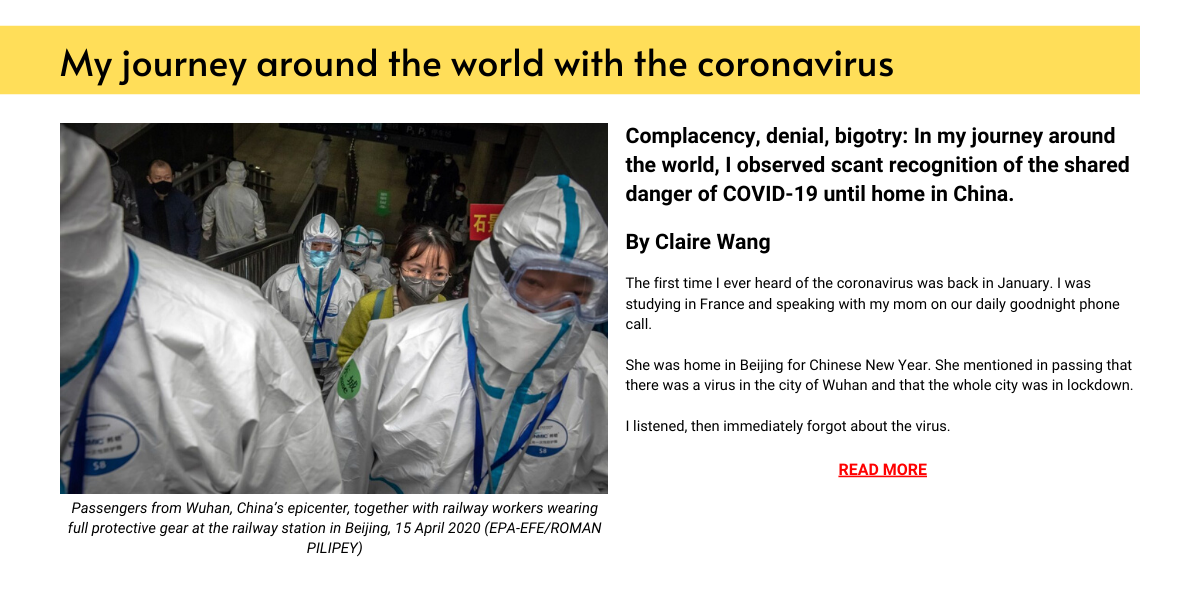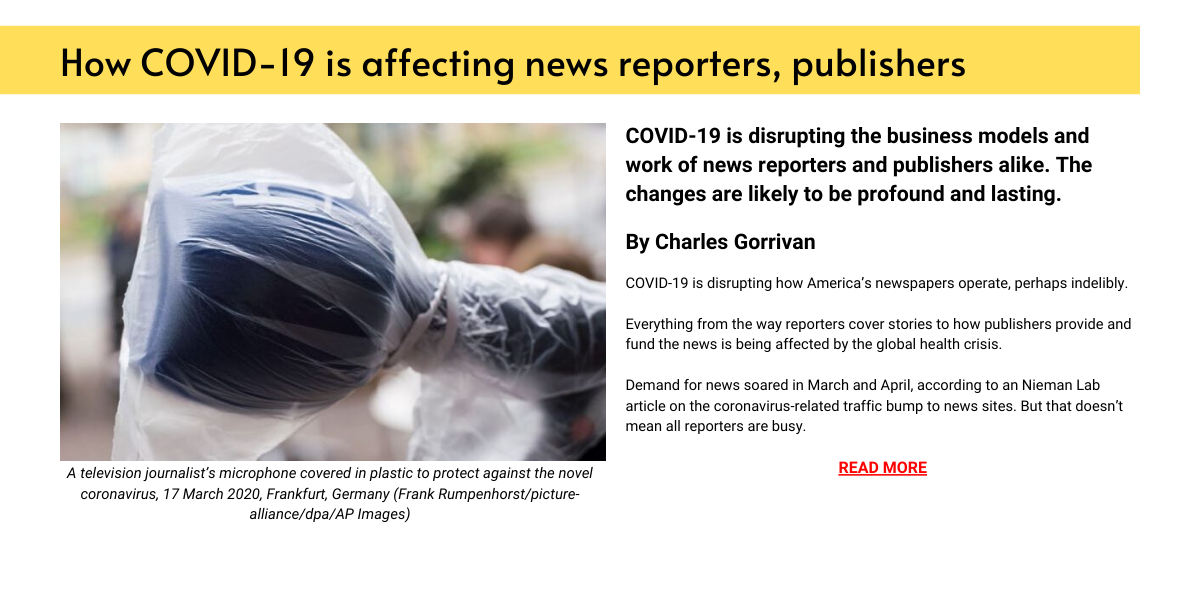What’s the secret to good writing? It’s a process that can push authors outside their comfort zones as they challenge their assumptions.

In her award-winning story, Claire Wang looked dispassionately at three countries as they struggled with COVID-19.
“Writing is easy. You just open a vein and bleed.”
There’s a debate over who said that first, but little matter. Whether it was Red Smith, Paul Gallico, Friedrich Nietzsche or Ernest Hemingway, we get the point: What you read might look easy; how it gets there is not.
We don’t expect News Decoder’s writers to open their veins, but they invariably push themselves beyond their comfort zones to come up with the goods.
Many young writers think it’s a matter of spilling thoughts onto the page, the main challenge being word selection, spelling, grammar, paragraphing and the like.
We tell them: The good news is that the “writing” is the easy part; the bad news is that everything that comes before is hard. The best stories emerge from an often lengthy process that involves introspection, questioning your assumptions, gum-shoe reporting, swallowing constructive criticism and revision, revision, revision.
Writing is easy once you have the raw goods.
So, what makes a good story on News Decoder? Aware that dissecting stories is a bit like trying to tell someone why a joke is funny, I asked my three colleagues in the trenches here to choose their favorite articles of late and to tell me why they so liked them.
Lauren Heuser, our chief strategy officer, chose Charles Gorrivan’s How COVID-19 is affecting news reporters, publishers. Gorrivan’s article, Heuser said, exemplifies how students can develop authoritative articles if they push themselves to dig into the issues and do original reporting.
 Gorrivan’s initial pitch reflected his keen interest in journalism and the impact the coronavirus is having on how journalists operate. But he was looking backward and counting on his instincts.
Gorrivan’s initial pitch reflected his keen interest in journalism and the impact the coronavirus is having on how journalists operate. But he was looking backward and counting on his instincts.
“Charles identified a timely and relevant pitch, but we helped him to narrow his focus, to make the piece forward-looking and to identify authoritative sources,” Heuser said. “He conducted interviews with a range of reputable sources, who provided the ‘raw goods’ that made the actual writing and editing of the piece relatively easy.”
The “raw goods” were quotes from experts in the field, who guided Gorrivan’s thinking and gave him what he needed. As we say in the news business, all he had to do then was spill out his notebook.
Coax the readers into your world.
Savannah Jenkins, our communications manager, chose News Decoder correspondent Barry Moody’s story, What history teaches Britain during COVID-19.
Moody is a veteran journalist who during a long career has witnessed momentous events that — true to the style of detached observers — he has typically recounted in the third person. But in his recent piece for News Decoder, he started off in the first person — “I” — and then skillfully mixed historical background with an analysis of current events.
 We encourage young writers to use the first person pronoun to coax readers into their world — while avoiding the assumption that everyone shares their viewpoints.
We encourage young writers to use the first person pronoun to coax readers into their world — while avoiding the assumption that everyone shares their viewpoints.
Here’s Jenkins’s take on Moody’s story: “As a reader, this helped me think critically on issues I read about daily in the news that were mentioned in the story, such as COVID-19, Brexit and rising populism in the EU. I was informed about the issues by the end of the article and curious to learn more. To me, these types of stories are the best!”
Writing means challenging your own assumptions.
Our intern, Angela Gu, picked Robert Conner’s Can student journalists save struggling local news?
Conner, according to Gu, mined data to lend authority to his piece, used strong quotations from sources and unleashed illustrative language.
 “After hyping up how student journalism covers local news, he ends the article with a reality check, listing the limits faced by student journalists, while still emphasizing the need for local journalism,” Gu said.
“After hyping up how student journalism covers local news, he ends the article with a reality check, listing the limits faced by student journalists, while still emphasizing the need for local journalism,” Gu said.
What stood out for me about Conner’s article was how he submitted five, very different drafts, reflecting an impressive gathering of original source material that added depth to his argument and challenged his initial thinking.
That’s something we tell our young writers: Tackle your subject with an open mind; you will never know where your research and reporting will take you.
Our process: pitch, report, draft, revise
Many of our aspiring writers are passionate about issues, even outraged. We urge them to put their emotions on the shelf for the moment while maintaining their excitement, to suspend their judgment, to speak to experts and those affected by events, and to rely on authoritative, solid data.
Those recommendations are part and parcel of our four-stage writing “process”: pitch, report, draft, revise.
 I’ll return to that process in subsequent columns. In the meantime, I can’t help citing one of my favorite articles of late — My elderly grandmother in China persevered during COVID-19, by Joyce Yang.
I’ll return to that process in subsequent columns. In the meantime, I can’t help citing one of my favorite articles of late — My elderly grandmother in China persevered during COVID-19, by Joyce Yang.
No, Yang did not dive into data about COVID-19 or quiz expert epidemiologists. Her story is not a scoop. But what she did is a lesson to many young writers: She used simple language to capture very complicated emotions as COVID-19 threatened her grandmother’s health and kept her family apart.
Yang is a Chinese national, and English is not her mother tongue. And yet she succeeded where so many native English speakers fail — by being simple and clear.
QUESTIONS TO CONSIDER:
- What is meant by the expression, “Writing is easy. You just open a vein and bleed.”
- What does the author mean when he says, “The good news is that the ‘writing’ is the easy part; the bad news is that everything that comes before is hard.”
- What News Decoder article do you especially like, and why?
Nelson Graves is the founder of News Decoder.

Nelson, your piece is wonderfully thoughtful and insightful. Full of practical advice for writers of all ages. And I loved your mention of using simple language, a practice too often ignored these days.